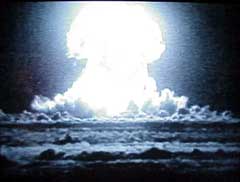In recent years historians and policy analysts have questioned President Truman's decision to use the atomic bomb against Japan. For President Truman, the decision was a clear-cut one. In 1945, America was weary of war. Japan was a hated enemy. The nation feared the cost of invading the Japanese mainland.
As visitors walk through this section, an audio loop program plays throughout the space with veteran testimonies about the end of the war. In addition to the audio loop, there are also four video monitors running silent video programs on four different topics that set the scene leading up to the decision to drop the bomb on Japan: the fierce fighting on Iwo Jima and Okinawa, the firebombing of Japan, anti-Japanese war propaganda, and the race to build the bomb.
Above the video screens is a series of scrolling messages in lights giving statistics about the war, such as casualty figures in various battles, the cost to build the bomb, etc. Displayed in a case is the map of Japan that was used by Presidents Roosevelt and Truman in the White House Map Room to plan the final campaign of the war against Japan.
A portion of this area will also be devoted to an "In His Own Words" flipbook in which Truman discusses the atomic bomb, and there are also quotations from contemporaries and historians both praising and condemning Truman's decision to use the atomic bomb.
Featured document in this section of the exhibit:
-
Secretary of War to Harry S. Truman, July 30, 1945, with Truman's handwritten note on reverse. No known written record exists in which Harry Truman explicitly ordered the use of atomic weapons against Japan. The closest thing to such a document is this handwritten order, addressed to Secretary of War Henry Stimson, in which Truman authorized the release of a public statement about the use of the bomb. It was written on July 31, 1945 while Truman was attending the Potsdam Conference in Germany. In effect, this served as final authorization for the employment of the atomic bomb, though the expression “release when ready” refers to the public statement.Papers of George M. Elsey.
Truman: In His Own Words
- Diary entry of Harry S. Truman, July 17, 1945, describing his first meeting with Stalin at Potsdam and expressing optimism in "handling" Stalin, as well as a reference to the atomic bomb. Papers of Harry S. Truman: President's Secretary's File.
- Diary entry of Harry S. Truman, July 18, 1945, recounting meeting with Stalin and Truman's intention of telling him about the bomb, as well as mentioning that the Japanese will surrender once Manhattan (the atomic bomb) is released on them. Papers of Harry S. Truman: President's Secretary's File.
- Diary entry of Harry S. Truman, July 25, 1945, in which he reflects on the atomic bomb tests and the destructiveness of it, and the plan for using the bomb on military targets only. Papers of Harry S. Truman: President's Secretary's File.
- Letter, Harry S. Truman to Bess Wallace Truman, July 31, 1945, describing negotiations among the Allies in Berlin. Papers of Harry S. Truman: Family, Business, and Personal Affairs File.
- Correspondence between Richard Russell and Harry S. Truman, August 7 and 9, 1945, regarding the situation with Japan. Papers of Harry S. Truman: Official File.
- Correspondence between Samuel M. Cavert and Harry S. Truman, August 9 and 11, 1945, regarding the situation with Japan. Papers of Harry S. Truman: Official File.
- Handwritten speech draft, December 15, 1945, detailing Truman's feelings on his decision to drop the atomic bomb on Japan. Papers of Harry S. Truman: President's Secretary's File.
- Correspondence between Irv Kupcinet and Harry S. Truman, including draft copies of Truman's letter, July 30 and August 5, 1963, responding to Mr. Kupcinet's column in the Chicago Sun-Times about the dropping of the atomic bomb on Japan. Papers of Harry S. Truman: Post-Presidential Files.
